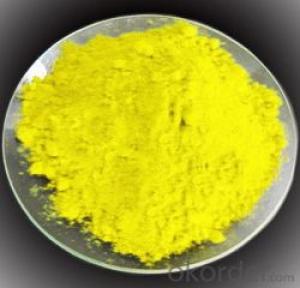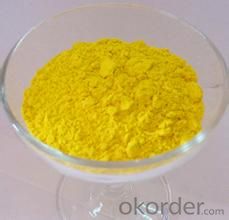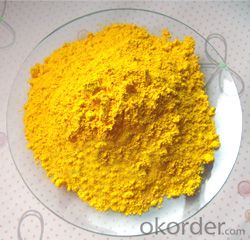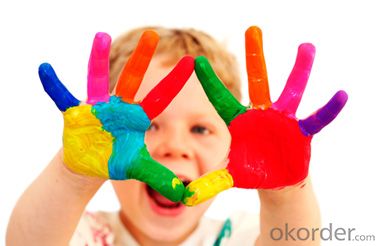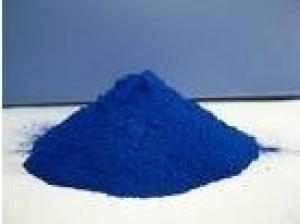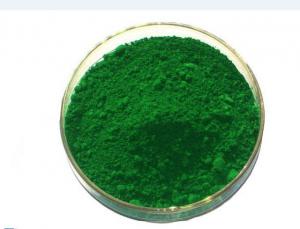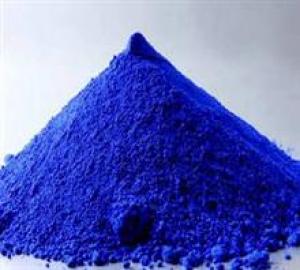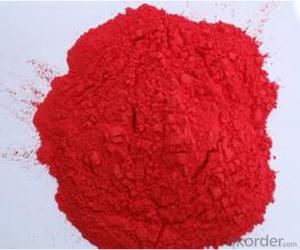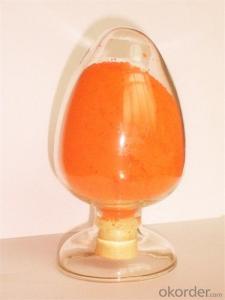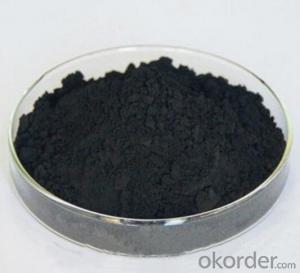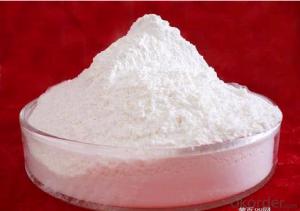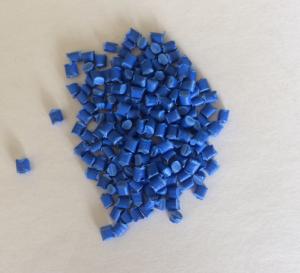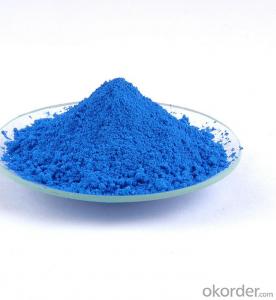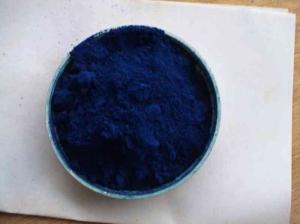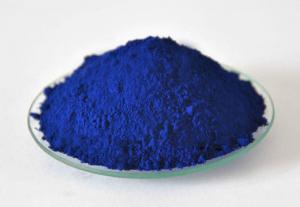Cadmium Yellow Acid Resistant Pigment Nanotmeter
- Loading Port:
- Tianjin
- Payment Terms:
- TT OR LC
- Min Order Qty:
- 500 kg
- Supply Capability:
- 6000000 kg/month
OKorder Service Pledge
OKorder Financial Service
You Might Also Like
Specifications of Cdmium Yellow:
P.Y. 37 Cadmium yellow, also known as 37 yellow pigment, as the bright yellow inorganic pigments, 537 cadmium yellow using membrane technology, environmental protection and low toxic properties. This cadmium yellow can be used to replace chrome yellow pigment, used in high-grade paint, fluorocarbon resin, plastic, etc.
Cadmium yellow | P.Y. 37 information:
Pigment name: Cadmium yellow
Cadmium Yellow Pigments index: P.Y. 37
Chemical composition: Cd/S
Product color: yellow powder
Cadmium yellow pigment properties: envelope
Pigment classification: metal oxide pigments
Cadmium Yellow | P.Y. 37 models:
Name | Type | Index | Appearance | CAS Index | C.I.Index | Thermal Endurance | Color Atla |
Cadmium Yellow | 537-1 | P.R.37 | Lemon Yellow | 68859-25-6 | 77199 | ≤300℃ | |
Cadmium Yellow | 537-4 | P.R.37 | Yellow | 68859-25-6 | 77199 | ≤300℃ |
Cadmium yellow | P.Y. 37 Parameters:
Acid-proof alkaline: soluble in acid
Sun resistance (1 ~ 8) : 8
Oil absorption: 27 to 30
PH: 6 ~ 8 g/cm3
Density: 4.5 ~ 5.9
Moisture: 0.5% or less
The average particle size distribution (D50) : 3 ~ 5 microns
Cadmium Yellow P.Y. 37 Features:
Cadmium yellow 537 is light yellow powder paint, insoluble in water, can be evenly dispersed in all kinds of resin, varnish, and apply to almost all resin plastic hair color.
Cadmium Yellow 537 performance similar to 5108 cadmium red, cadmium yellow but hiding power than cadmium red, even after coated environmental treatment, but it is still not recommended for close contact with the infant physiological situation.
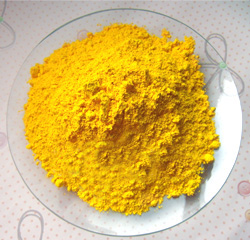
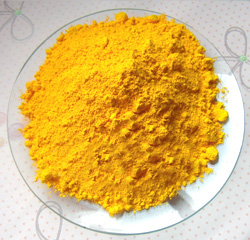
Cadmium yellow 537 paint tinting strength is strong, has good light fastness, weather resistance, good covering power, don't move, don't ooze color, can be used for outdoor boast skillful coloring.
Cadmium yellow 537 bright color saturation, its chromatographic range from light yellow is yellow to red light yellow.
Cadmium yellow 535 to fill cadmium yellow, not only reduces the cost, and some on paint, paint application performance is also improved, such as density and oil absorption, better dispersibility in organic medium, etc.
Cadmium Yellow Application:
Cadmium yellow 537 can be used for heat resistance coating, fluorine carbon plastic, color masterbatch, etc., used for traffic signs coloring, indicative warning facilities coloring, outdoor amusement facilities for children outdoor high weathering steel, plastic products, such as shading. Cadmium yellow at the same time, also applies to no more than 537 300 ℃ high temperature printing inks, paints and high-grade decorative coloring and other use.

Cadmium yellow 535 is particularly suitable for high cost performance, low cost of paint, paint, etc. For the use of colorants
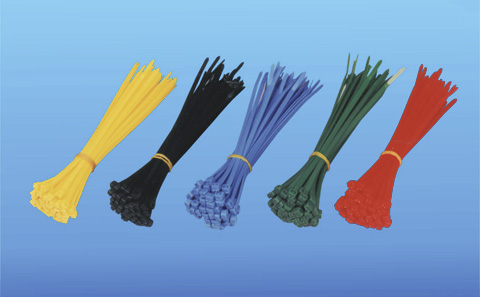
- Q: I need to find powdered paint or pigment that I can throw, for some photographs.Preferably cheap, and that wouldn't stain skin.I've looked into powder paint, though this tends to stain skin for about a week.Thanks :)
- There are diverse varieties of eyeshadows, which means diverse finishes. Matte, working example, would be very, very centred interior the colour, wherein as a lustre will reveal up sheer, and additionally you will possibly be able to barley get any precise pigment out of it. MAC paint is for a base, or primer on your eye lids, which means you will possibly be able to placed that on until now you place any eye liner, shadow, pigment, etc. based on the colour paint you make the main of, it would strengthen or tone down and eye shadow or pigment then you definately definately challenge on the lid. Pigment is a very, very centred loose powder. You superb want a tiny, tiny pinch of it, and the containers they arrive in, circulate a verrrry sturdy distance. The purpose persons customarily use pigments as a shadow alternative, may be in view that the the two MAC does now not deliver the precise colour of the paticular pigment in a shadow, or they are applying it to extend shadows, or finally, they are mixing it with shadows to create diverse colors. desire that's assisting.
- Q: (Explain what happens when a pigment molecule is struck by electromagnetic radiation in the visible light spectrum.)
- pigments are molecules that absorb electromagnetic radiation. For example, the chlorophyll pigment in plants absorbs blue and red light, which is why they reflect green light (since green is the color not absorbed). Another example is melanin, which is the pigment that darkens the skin of people. Melanin absorbs UV to protect the skin. A pigment molecule struck by EM radiation in the visible region may absorb some of the light depending on what pigment it is.
- Q: What are MAC eyeshadow pigments? Are they just like regular eyeshadow.. are they used the same way? Has anyone tried them and liked them?
- NEVER TRIED THEM HEARD GOOD THANGS THO
- Q: What pigments are used in photosynthesis?
- Chlorophyll(green) is the primary pigment used in photosynthesis. Besides chlorophyll, plants also use pigments such as carotenes(orange) and xanthophylls(yellow).
- Q: What do chlorophylls, cartenoids and phycobilins reflect? And what wavelengths of light do they absorb?
- Carotenoids generally reflect yellow, orange, or red and absorb blue to blue-green light spectra. Xanthophyll absorbs well at 400-530 nm Beta-carotene absorbs most strongly between 400-500 nm. Fucoxanthin absorbs light primarily in the blue-green to yellow-green that penetrates deeper in water, peaking at around 510-525 nm and again at 450-540 nm. This reflects a yellow brown giving brown algae their color. Phycobilins are not found in leaves except as a phytochrome. They occur in Cyanobacteria (bluegreen algae) and Rhodophyta's (red algae) photosynthetic pathways as accessory pigments a part of the light reaction pigment systems energy donors to the reaction center. Phytochromes respond to far red between 700-800 nm. Phycoerythrin is a phycobilin pigment in rad algae that reflects red light and is therefore responsible for the color of most red algae.
- Q: what is the pigment in hibiscus?
- Hibiscus flowers bear pigments of three types: carotenoids, anthocyanins, and flavonols. The exact pigments (all three of those types are actually sizeable families of similar chemicals) and the exact proportions depend on the color of the particular flower: there are literally several hundred species in the genus Hibiscus, and they come in all shades of red, pink, yellow, and orange. Carotenoids are oil-soluble, fairly stable pigments that come in all shades of red, orange, and yellow. Anthocyanins are water-soluble and significantly less stable: they're responsible for the blues, pinks, purples, and reds, and in high concentrations can produce colors so dark as to look black. Flavonols are the least vivid of the pigments: they produce pale pastel yellows, cream colors, and off-whites. (Plain white flowers usually have no visible pigment at all.) Flavonols actually do most of their color absorption in the UV spectrum: they're the plant equivalent of the melanin in human skin, keeping them from getting sunburnt.
- Q: whats it for? lol
- itz for ur beautifing ur skin.
- Q: what is pigment?
- a pigment has some kinds like biological pigment and arsenic pigment. i dont know much about the arsenic pigment. i would just tell something about the biological pigment. in biology, pigment is any material resulting in color of plants or animals cells. many biological structures like eyes,fur,hair and skin contains pigments like melanin in specialized cells called chromatophores.
- Q: the absorption spectrum and the range of light reflected by each
- A okorder /... gives the spectra (Action and Absorption)
Send your message to us
Cadmium Yellow Acid Resistant Pigment Nanotmeter
- Loading Port:
- Tianjin
- Payment Terms:
- TT OR LC
- Min Order Qty:
- 500 kg
- Supply Capability:
- 6000000 kg/month
OKorder Service Pledge
OKorder Financial Service
Similar products
Hot products
Hot Searches
Related keywords
